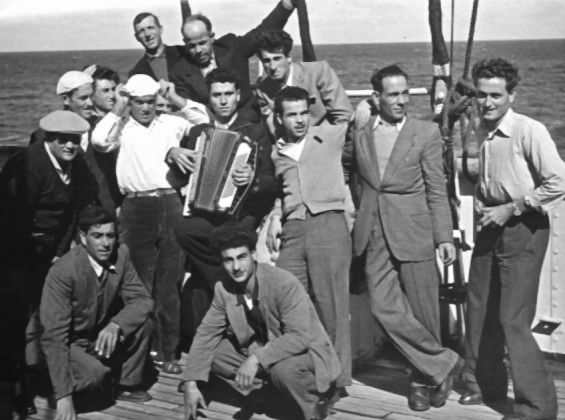Much has been written on the topic of Italian emigration to America in the 19th and 20th centuries. But despite the vast amount of research on the topic, the ocean crossing itself, perhaps the biggest single event in the immigrant experience, is also one of the least studied. And though it permanently marked their lives, once they arrived in the New World, immigrants, for their part, seemed to have left the memories of the journey onboard the ship.
During my many trips to Canada, I met many Italian immigrants who left Italy in the 1950s and 1960s. They were all happy to tell me about their present lives, the beautiful houses they had bought, and the brilliant careers of their children. But nobody seemed to want to discuss the ocean crossing – the days they spent inside that “immense steel vessel,” as author Pascal D’Angelo called it.
It was for this reason that I always pictured the crossing experience to be an ordeal – one that every immigrant wanted to remove from his or her mind. It appears, however, that I was wrong, and for this I have to thank Antonio, a Sicilian immigrant. Antonio let me understand that the picture I had formed – nourished by the books I had read on the topic and my own bias – was misleading. I met Antonio on a flight from Rome to Toronto; he was sitting next to me. He seemed quite old, perhaps in his eighties, but still strong. Dark eyes, olive skin, big hands. He was born in Sicily and immigrated to Canada in the 1950s when he was a young man.
Antonio didn’t seem comfortable on the plane, nor was I. I had some trouble, as the plane ran into an air pocket. He saw that I was nervous, looked at me and smiled. He spoke to me in Italian: “Lucky you, travelling by plane! The first time I came to Canada, I had to board an old rusty ship in Naples. These air pockets are nothing compared to the rough water! We went through building-size waves!” Prompted by the air turbulence, Antonio began to tell me the story of his ocean crossing.
Through his recollections, I began to understand what that voyage represented for him and the hundreds of other Italians with whom he was travelling. I understood that in those days, sailing through the middle of nowhere, made him feel like he was almost hanging in time, balanced between a hastily abandoned past and a suddenly precarious future. He didn’t know anything about Canada, except for what he had heard in his tiny village, lost in Sicily’s inland mountains: “In Canadà ci stavano tante belle gherle e i money” (In Canada, there were many beautiful girls and money). Warily, for he had been widowed many years, he told me about love affairs that had taken place on the journey across the waters. Contrary to my expectations, he seemed to remember every detail from that cruise – dates, sounds, scents.
After that particular journey to Canada with Antonio, I realized that it was worth trying to investigate other stories like his – to reconstruct the crossings, the daily life on board, and the immigrants’ memories and feelings – the kinds of stories which had never really been heard.
I set out to interview elderly Italian-Canadians, mostly around the Greater Toronto Area, about their crossings into the country. It usually took some time to gain the individuals’ trust and get them to remember. But as they began to feel comfortable, they inevitably began to recount their memories. The stories were unexpected and at times astonishing.
At the same time I started looking for more stories through other primary sources such as diaries, letters, and autobiographies. I did so both in Italy, thanks to institutions like the Paolo Cresci Foundation in Lucca, and in Canada, through institutions like Canada’s Immigration Museum at Pier 21 in Halifax.
I also searched through literature that was based on real events and memories. I discovered how helpful cinema could be for my research by watching movies like Nuovomondo by Emanuele Crialese and La Leggenda del Pianista sull’Oceano by Giuseppe Tornatore. I also viewed The immigrant by Charlie Chaplin and Titanic by James Cameron. These diverse research materials were the key that allowed me to enter the immigrant’s world.
Through first-person accounts, I was introduced to immigrants from the late 19th century. Francesco Sartori of Veneto, for example, wrote a letter in 1877 to his relatives, reporting that he and the ship’s other passengers lived compressed as in a beehive (as quoted by Emilio Franzina). Rosa Cavallieri, from Lombardia, who crossed the ocean in 1884, wrote in her autobiography about the pitiful accommodations:
“All us poor people had to go down through a hole to the bottom of the ship. And in that time the third class on the boat was not like now. The girls and women and men had to sleep all together in the same room. The men and girls even had to sleep in the same bed with only those little half-boards in between to keep us from rolling together. But I was lucky. I had two girls sleeping next to me.”
Through Cavallieri I learned about terrible storms when “the sky grew black and the ocean came over the deck.” I could imagine the hundreds of passengers trapped in the dark steerage like rats in a hole, without air and light. I spoke to many immigrants who recounted getting sick because of the storms and fearing that the ship would sink, and praying to God.
But when the sea was calm, the crossing could be an enjoyable experience. In fact, once the passengers had done the few daily chores required by life on board a ship, there was a lot of free time. The immigrants used to spend those leisurely hours playing cards, throwing dices, or just looking at the ocean from the upper deck, gazing down at the fish. One of the most common pastimes was to play music and dance. Remembers Rosa Cavallieri:
“One man had a concertina, and the ones who knew how to dance were dancing to entertain the others. Me, I was the best one. There was no one there to scold me and tell me what to do, so I danced with all my paesani who knew how. I even danced with some of the Polish and the French. We were like floating in a cloud in the middle of nowhere, and when I was dancing I forgot for a little while that I was the wife of Santino going to him in America.”
The most common activity for men, both bachelors and married, seemed to be looking at women. When there was some good-looking girl on board, many tried to get her attention. In the words of Rosa Cavallieri: “We were in the middle on nowhere,” far away from relatives, mothers-in-law and husbands-by-proxy. That was the point. Being away from the mainland made people feel free even if, in fact, they were not.
When it came to onboard love affairs, what happened during the crossings mostly remained locked in the immigrants’ memories for years, maybe even for a lifetime. There was an unspoken agreement: once on land, everyone went his or her own way without looking back – New World, new beginning.
Osvaldo Zappa, who emigrated to Canada in 1956, writes in his autobiography, Giovanni’s Journey, about the attraction he felt towards Anna, an Italian woman crossing the ocean to join her fiancé:
“I liked Anna more and more; I think she felt the same about me. We sought each other’s company. When I thought about her going to get married to some other fellow in Ontario, it started to bother me somewhat. She seemed to be sincerely attracted to me. Very often we remained very late at the bar, sipping drinks and chatting. Occasionally, we would step outside on the wintry deck holding hands.”
As the port of Halifax drew near, Zappa knew that his time with Anna was running out. He writes, “Anna would be on the train with me at least as far as Sudbury, the end of her journey. ‘She will vanish as if she had never existed,’ I thought.”
An Italian immigrant from Molise who wanted to remain anonymous told me a story about a girl from his village who, in the 1950s, arrived in Canada engaged to an Italian-Canadian man. She supposedly had left Italy a virgin. She arrived in Halifax, her fiancé and family there to welcome her. On her wedding night, however, her husband discovered that she was not a virgin! She was roughed up and sent back to Italy on the first available ship, dishonoured for the rest of her life. It seems something had happened during the crossing…
Conditions on ships between the end of the 19th century and fifty years later improved a lot for the third-class passengers. In his diary, Tommaso Bordonaro describes life on the ship in 1947. He was especially enthusiastic about the food that was served onboard, in terms of both quality and quantity. There was pasta, various kinds of meat, coffee, butter (which in Italy, he says was extremely rare), sugar, honey, and fruit. In the Italy of the times, this variety of food could only be had by the rich: “Il caffè ed il latte si usava come si usava l’acqua in Italia quando si era in campagna. E questa vita per tutto il viaggio” (We drank coffee and milk the way people drink water in the Italian countryside. This was true for the entire journey.) Bordonaro reports that many passengers had brought their own food for the crossing: cheese, biscuits, almonds, liquor, lemons, and oranges. When they finally got around to opening the food bags, the food had rotted.
Many unpleasant aspects of life onboard, such as fears of the ocean and storms at sea, were common among travellers in both centuries, as was the recurring theme of the sorrow for what was being left behind and the uncertainties for the future. But the enjoyable side of the journey, however short lived, cannot be understated.
Indeed, by the 1960s the price of intercontinental flights became affordable, and the unique world of the immigrant ships began to disappear. Hundreds of ships fell into disuse or were turned into cruise liners. By the 1970s, Italian immigration had ebbed considerably. Emigration as a mass event all but ceased, or was turned into a solitary process. In a flight that lasts a few hours, there is no time to socialize with other immigrants, to make friends, to share feelings, fears, and regrets.
The ocean crossing was not just an ordeal, as is commonly thought, but also represented for many immigrants the opportunity for freedom: sailing on the calm sea, allowed them to sing, dance, share dreams and desires, make new friends, start over, and sometimes, even find new loves.
Michele Campanini teaches at the University of Siena. His last book Racconto e rappresentazione del viaggio di emigrazione oltreoceano: Storie, memorie, voci was published in 2010.
First published in Accenti Magazine, Issue 20.




